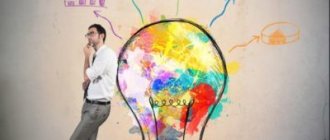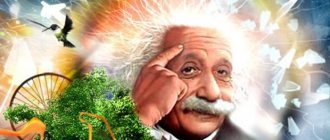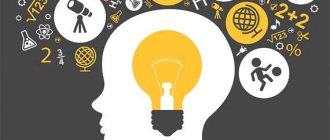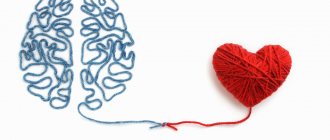What is thinking
Human thinking is the main achievement of millions of years of evolution. The world as we see it now is the result of the mental activity of the most outstanding representatives of Homo Sapiens.
In the broadest sense of the word, thinking is the process of processing information by the mind on the basis of a person’s existing knowledge and accumulated experience. As a result of this process, the initial information is analyzed, systematized, classified and acquires a new quality.
Why do you need to develop your thinking? The better it is developed in a person, the more effectively he interacts with the environment, other people, and in general, the more successful he is in life.
Thinking begins to form in early childhood and goes through several stages in its development. Scientists have found that the development of thinking of an individual person repeats the development of thinking of all humanity.
First, we learn to interact with specific objects, highlight their main properties and characteristics, and then we begin to operate with abstract images and concepts in our minds.
Intensive development of thinking occurs until about 20 years of age, then it slows down and can completely disappear if it is not consciously dealt with.
Why do you need imaginative thinking?
The earlier a person addresses the issue of developing imaginative thinking, the more serious the success will be in this. In childhood, no specialized training is required: in a playful form, a child of any age is able to imagine an imaginary object or situation and describe its characteristics or actions - such games are loved by children and do not present any difficulties. At some point, the child comes to the understanding that the senses are not enough to obtain knowledge or explain interesting phenomena and events - thinking will become an assistant in filling this gap in comparisons, differences and disclosure of relationships and connections between ongoing surrounding phenomena.
The imaginative thinking developed from childhood later becomes the basis for the development of logical and verbal thinking, necessary for successfully completing a course of school disciplines and subsequent training and mastering a profession.
For adults, developed imaginative thinking is something that representatives of creative professions cannot do without, including modern web and graphic designers and those who use verbal descriptions in their activities (for example, journalists and copywriters). The proposal to “draw something beautiful” or “write something interesting” should not confuse such specialists: imaginative thinking immediately begins to work creatively, turning to the analytical abilities of the individual.
In addition, for people of other professions, having developed imaginative thinking will not hurt at all: a sharp mind and a broad outlook are valued in society and attract people. And in everyday life, imaginative thinking will become an indispensable assistant:
a non-standard approach to the situation or circumstances that arise makes it easy to solve problems; imaginative thinking becomes a kind of psychological defense mechanism against an unpleasant person or a nervous situation: imagining the stimulus in a comical or absurd image (imagining an opponent in the image of a hamster is especially popular) will smooth out the situation and calm it down; visualizing an idea or dream with the smallest details in mind makes the realization of what you want easier and more real.
Ultimately, the greater the physical and psychological capabilities of one’s own body a person uses, the more interesting and eventful his life, communication with other people, and more complete self-realization.
Types of thinking and ways to develop them
In psychology, there are several classifications of types of thinking. The most frequently used classification is based on the nature of mental processes occurring in the brain. This is where we will focus our attention. According to it, the following types of thinking are distinguished.
Visual-figurative
This type of thinking is closely related to the visual perception of objects and occurs in the right hemisphere of the brain. In the process of visual-figurative thinking, a person interacts with images of specific objects that are in short-term and operative memory.
For example, a child sees a picture of a ball flying towards the window and can figuratively imagine the development of the situation.
The older a person gets, the less often he resorts to visual-figurative thinking. Therefore, over time it begins to limp. If you've ever done a renovation, you know how difficult it can be to imagine a room with new wallpaper on the walls and furniture standing differently.
Fortunately, it can be developed at any age. The methods of development in an adult and a child are the same, so you can do this together with your child. Here are some simple tips:
- Every day before going to bed, remember your entire day in bright colors. Who did you meet today? What were these people wearing? What was the design of the buildings you entered? The more details you remember, the better.
- Perform unusual manipulations with images in your mind. For example, imagine that a bear and an elephant switched ears. Or that the whale grew legs. Don't limit your imagination. The more ridiculous a picture you can imagine in your mind, the more it will give impetus to the development of thinking.
- Several times a day, focus on some objects and try to find as many words as possible to describe them.
Visually effective
This type of thinking first begins to form in children at the age of approximately 1.5 years. It is associated with the manipulation of specific objects. A person solves practical problems directly in the current situation, performing certain actions. Visual-effective thinking is also called manual intelligence.
For example, a child builds a tower from cubes, sculpts from plasticine, or assembles a construction set. Or an adult rearranges furniture, lays parquet flooring, sews a button on trousers.
The left hemisphere of the brain is responsible for this type of thinking. You can develop it in the following ways:
- play chess;
- collect puzzles;
- make crafts from scrap materials;
- sculpt from clay or plasticine;
- fold origami figures from paper;
- build something from a constructor.
Abstract-logical
It is also often called verbal-logical or theoretical. The highest degree of mental activity available only to humans. With its help, we can “unstick” the thought process from specific objects and operate only with abstract concepts.
This type of thinking begins to develop at the age of 5–7 years. By the age of 16, as a rule, a child can already use it like an adult. Namely, analyze information coming from outside, highlight the properties of objects and phenomena without direct contact with them, classify and systematize data, isolate the main and secondary, etc.
The child learns to count using material objects at hand: fingers, cars, apples, cubes. If at this stage you try to explain to him what numbers are, he will not understand. Then, already at school, he will be able to make calculations without manipulation, resorting to the help of only abstract concepts.
Abstract-logical thinking operates in three main categories:
- A concept is the simplest unit of mental activity. With its help, we name an object and transfer it to the abstract plane, assigning it to a category already known to us. This is done on the basis of its essential features. Example: we see an airplane, identify the main features (two wings, a tail) and call it an airplane based on its similarity to similar objects already familiar to us.
- Judgment is the establishment of a relationship between several concepts and the formation of new concepts on the basis of this. An example of a proposition: “A plane, a car and a train are modes of transport.”
- Inference is the formation of new judgments from existing ones. “A plane is a mode of transport. Transport transports people and goods. The plane transports people and cargo.”
The development of abstract logical thinking should be given special attention to both children and adults. In the course of his life, a person most often uses it, with rare exceptions. Success in all areas of life depends on how well it is developed.
Here are some simple tips for its development:
- read words and sentences backwards;
- come up with contradictory phrases: bitter sugar, hot ice, solid liquid;
- compose fairy tales and stories with all kinds of plots;
- try to create visual images of abstract concepts in your head: inspiration, harmony, spirituality, hypothesis, etc.
Creative
This type of thinking allows us to process the most ordinary information in unusual ways, while obtaining qualitatively new results. It lies at the heart of all great inventions and works of art. Without it, we would not be able to move beyond existing algorithms and patterns.
If your creative thinking is poorly developed or not developed at all, then you do not know how to be flexible and respond to emerging changes. By upgrading it, you will not only become more efficient, but also begin to live a more interesting and rich life. So I advise you to start right now. Here's what will help you with this:
- Learn something new every day.
- Do ordinary things in unusual ways.
- Travel more.
- Include improvisation in the most ordinary life situations.
How to develop thinking
Thinking is the most difficult of jobs. Apparently, this is why so few people do it.
Henry Ford
When a person asks the question of how to develop thinking, then we can say with complete confidence that he perfectly understands the role it plays in our lives.
And this role, believe me, is huge. Thanks to developed thinking, each of us can achieve very high results in almost any business, even without having the necessary knowledge for this, since well-developed thinking will easily lead a person to any knowledge he needs and will allow him to use it competently. Thinking is the most important tool for a person in this world. There are many types of thinking, as well as ways to develop them. And each type of thinking has its own advantages and some, as a rule, not very significant, disadvantages. Thinking can be: logical, analytical, deductive, inductive, systematic, creative, and so on. In this case, any thinking is reduced to one common action that allows it to function. And in order to develop thinking, you need to learn how to perform this action effectively. In this article I will tell you what and how you can do to develop your thinking. First, let's, friends, find out what thinking is. As you may know, there are quite a few definitions of thinking [as, indeed, of everything else in this world], each of which reflects different sides, or aspects of this rather complex class of mental processes. And without a doubt, each of the definitions has a greater or lesser right to exist and each of them is useful in its own way. I will give thinking my own, as I believe, the most correct and accurate definition, from which we will proceed in the future. It is different from the definitions you may find in books on the subject. But it suits me quite well, and I hope it suits you too.
Thinking is the process of searching for necessary and/or new information, or, if you like, searching for truth, using questions that a person poses to himself and then moves in a variety of directions to find several answers to each of his questions and choose from them is the most correct answer from his point of view. This search must be carried out by a person both in the external and in his internal world. Or we can also say this: thinking is the process of switching a person’s attention with the help of questions he poses to himself from one information to another and establishing a logical connection between these pieces of information. Moreover, information can be not only real, but also fictitious, when a person himself comes up with something new, that is, he comes up with a new answer to his question. The quality of thinking is precisely determined by a person’s ability to come up with new information, or to very skillfully manipulate the information he already has in order to find a solution to some issue, some problem, to find something that he does not yet know about. That is, new information, new knowledge can be invented with the help of correctly posed questions to oneself.
Thus, everything that concerns thinking comes down to a person’s ability to pose the right questions and look for answers to them. Moreover, the more intense, intense and complex this search, the better and more effective a person’s thinking. And the simpler the search for information, the fewer questions a person asks himself and the faster he finds the easiest answers to the questions that arise before him, the weaker his thinking. For example, if a person does not look for new information at all when some questions arise before him, but is content with ready-made answers that he knows and which, from his point of view, are not just correct, but the only correct ones, but in fact often turn out to be superficial and outdated , then it is simply not possible to say that he has a well-developed thinking. And it’s another matter when a person actively seeks or, in some cases, even comes up with answers to his questions, that is, creates new information based on existing information. In this case, we can say that his thinking is well developed. But asking yourself the right question in order to use it to come to another right question, and then to another question, and so on until the answer needed to solve a specific problem or task is found, is very difficult. That’s why it’s impossible to really develop your thinking well by solving puzzles and puzzles, solving crosswords, playing chess, logical puzzles, solving Rubik’s cubes and the like. These are all children's games for our thinking. In order to develop, it must work on more complex and at the same time competently posed tasks, solving them with the help of correctly selected questions.
Let me briefly explain how our thinking works. Our thoughts, if we consider them as a process that we call thinking, are a kind of hooks that connect some images and concepts in our head with other images and concepts. We call this connection a cause-and-effect relationship, when another follows from one phenomenon, or another from one statement. And images and concepts are the types of information with which we operate. But when we consider our thoughts as information that is stored in our head in the form of images and concepts, then with the help of questions and searching for answers to them, we establish cause-and-effect relationships between these thoughts [between cells of information] and with their help We collect a general picture of the vision of the world or a general picture of a particular situation. That is, you see, friends, our thinking is a kind of instruction for working with information, which is based on correctly posed questions.
Above, I said that a person himself must pose questions to himself in order to think, but in fact, thinking is activated, or better said, launched, when searching for answers to other people’s questions. Because other people's questions, in turn, give rise to questions in your head. Well, let’s say I ask you the following question: “How can I light a fire?”, and you already need to start thinking, start looking for information in order to answer me something. How will you do this? You will also ask yourself the question - what and how best to answer me. You can tell me that you don’t know how fires are lit, or you can provide me with the necessary information on this issue if you have it, or you can come up with something else, for example, ask a counter question: “Why do you need this?” . This choice that you will make when deciding what and how to answer me is a thinking process that will consist of the questions you pose to yourself and the search for answers to them. If you think about your answer very well, paying enough attention to it and going through all possible options in order to find the best one, then your thinking will be conscious, and if you answer automatically, then your thinking will be unconscious. It also consists of questions and answers, but they do not come into your field of attention, so you cannot control them. So a question that comes to you from the outside will inevitably lead to several questions arising inside your head, which will trigger the thinking process. If the question is complex, you will have to tinker with the information you have before you can come up with a suitable answer, provided your thinking is conscious. You may need to somehow update the information you have to tailor it to a specific situation, or you may want to ask follow-up questions to the person asking the question or questions to better understand what question you need to answer. . In other words, all thinking is based on questions and answers. This is to put it simply. And you and I don’t need to complicate this issue.
As you can see, friends, having defined thinking, we have already partly answered the question of how to develop this very thinking. You need to learn to ask yourself the right questions and be able to find answers to them, both right and wrong. And then determine which of the answers found may be correct. And to do this, again, you need to ask the right question, which will allow you to move even further and clarify even more information for yourself. In general, the process of thinking is not an easy process. It was always hard to think. But it needs to be done.
So, what have we found out? We found out that in order to develop thinking, it is necessary, firstly, to launch it, and secondly, to improve its work. How to start thinking? To do this, as we have learned, you need to ask yourself the right question. Which question is the right one? The right question is first and foremost a question about a question. This is the very first question you need to ask yourself when thinking about a particular issue. That is, you must understand - why do you rack your brains over the question facing you, why go deep into any topic at all, for what purpose will you do this? You see, anyone, even the smartest person, can be loaded with information that is absolutely useless to him, so that his brain begins to work on it, to the detriment of more important matters. In this way, a person can simply be distracted from thoughts that are important to him. But that’s what thinking is given to us, to prevent such situations. Therefore, by asking why we need to think about anything at all, we can control our thinking and use it to our advantage. Therefore, I repeat, the question of the question is the very first question that you need to ask yourself in order to properly adjust your thinking.
Next, you need to think about how many answers there may be to a particular question to which you have decided to find an answer. In order not to think linearly and stereotypically, you need to take a broader look at the issues facing you. Never allow yourself to be satisfied with just one answer to a particular question - look for as many answers as possible, asking yourself what they, these answers, could still be, in addition to those that you already know. The more options you find, the better. If you can't find new answers, come up with them. And no matter how absurd they turn out to be, the main thing is that they will not allow you to slow down your thinking by stopping the process of searching for answers through new questions. And this process must necessarily last as long as possible in order to give your brain the load it needs for its development, thanks to which you can, so to speak, upgrade your thinking. It's like with muscles - you can't do one push-up or one pull-up to make them grow and make them more resilient. Muscles must be loaded until they exceed the limit of their capabilities in order to adapt to new loads, only then will they begin to grow and become more resilient. And only then will your thinking begin to develop when, with the help of the necessary load, it goes beyond its current capabilities. Therefore, ask yourself questions and search, construct, come up with answers to them until you feel that the limit of your mental capabilities has been overcome. The brain must get used to building logical chains, creating cause-and-effect relationships, finding new information with their help, generating new information, connecting images and concepts with each other and constructing from them a holistic picture of the world or some particular phenomenon. So try to make automatic decisions as little as possible, no matter how correct they may be, so as not to wean your brain from thinking. You can train your thinking in this way constantly, in any situation - simply by showing curiosity about everything that surrounds you and asking yourself more and more new questions about what you want to know.
And finally, the last thing I want to tell you about in this article, but not the last thing in this matter, is the curiosity I already mentioned above, as well as such a thing as doubt, or better said, the state of doubt. With the help of doubts and curiosity, you can generate an incredible number of questions, the search for answers to which will allow you to actively develop your thinking. Curiosity encourages a person to look beyond what he knows. With its help, a person can ask questions about a variety of things that he would like to know as much as possible. And curiosity plus doubts prompt a person to doubt those truths that he already knows. And then he asks a very important question, both for any scientist and for each of us: “Why is something arranged the way it is, and why does something work the way it works?” So curiosity helps us think broadly and far, and doubt plus curiosity helps us think deeply. The main thing is that you, friends, have questions, and you are not satisfied with the answers to them that you know, but look for answers to these questions that are new to you and new in general. Then your thinking will work and develop.
I can’t help but tell you that I have a very interesting training program that allows you to develop your thinking. It comes down to the two main actions I described above - the ability to ask yourself questions and the ability to find answers to them using other questions. This program is very unusual, you probably have never encountered anything like this in your life, because, as far as I know, few places teach the ability to ask questions, especially to ask yourself; basically everywhere they teach people something with the help of ready-made answers. So if anyone is interested, you can try to pump up your brain in an unusual, but very useful way for the development of thinking.
Finally, I would like to briefly tell you how you can benefit from having a highly developed mindset so that you do not lose motivation to work on developing it. Nowadays, friends, knowledge is no longer the power it used to be. They are still very important and need to be received, but thinking comes first in importance. Whoever has it more developed is stronger, or, if you want, more successful in life. But knowledge today quickly becomes outdated, and it is accessible to many. Today, almost everyone can get the necessary knowledge, the necessary information - at any time and in any place. You can download so much information into the same cell phone that you will not be able to master in your entire life. And search engines answer any questions faster and more accurately than anyone, even a very smart person. Therefore, it is not so important to know a lot; it is much more important to be able to correctly use the knowledge you have and find, or even better, invent new knowledge and create new information. And in order to work productively with different information and benefit from it, you need to have developed thinking. It will help you quickly solve any problems and tasks.
Mental operations
To give you an idea of what a multifaceted and complex process our thinking is, I will list some of its capabilities. Even the most powerful computer next to it will seem like a child's toy.
- Comparison – highlighting the similarities and differences of several objects. “The shape of an apple is similar to a peach, and the color of a pear.”
- Analysis is the division of objects into their component parts. “A chair consists of legs, a seat and a back.”
- Synthesis is the joining together of disparate elements. “Stick, stick, cucumber - so the little man came out.”
- Induction is the derivation of inference from the particular to the general. Distribution of knowledge about one object to a group of similar ones. “This dog chews a bone, so dogs can chew bones.”
- Deduction is the opposite of induction. Endowing an object with specific properties based on its membership in a group. “Ants can lift objects heavier than their own weight. So this particular ant can lift more than its own weight.”
- Combination – searching for solutions to a problem based on a combination of different methods. Underlies combinatorial thinking. Used, for example, when playing chess.
- Divergence is the search for multiple solutions to one problem. We use divergent thinking during brainstorming.
- Convergence is the search for the only correct solution based on learned algorithms. It is used when solving problems in which there can be only one correct answer and it can be obtained only in one way.
This is not all the capabilities of our brain. If you want to learn more, I advise you to read special books on thinking development. We will look at some of them towards the end of the article.
Universal recommendations for developing thinking
Let's move on from theory to practice. Follow our guidelines to sharpen your mind and make it razor sharp.
Read more
Nothing contributes to the development of mental activity more than reading. Just be careful - not all literature is equally useful. Pulp novels, second-rate detective stories, memoirs of pop stars only clog the brain.
I advise you to read classical literature, encyclopedias, books on philosophy and psychology. The process of reading itself activates various parts of the brain, and the information that we draw from books expands our conceptual apparatus.
Use your left hand
We all know that the left hand is connected to the right hemisphere, and the right hand to the left. Most of us are right-handed, so our right hemisphere is much less developed. But it is precisely this that is responsible for creative and imaginative thinking. To bridge the gap between the two halves of the brain, you need to start using your left hand as often as possible (for left-handers, the right).
Here are some ideas of what you can do with your left hand without compromising the result:
- brush your teeth;
- open the door with a key;
- eat with a spoon;
- type a message on your phone;
- paint.
At first it will be unusual and the actions will take longer. But then you will get used to it and feel the effect. Thinking will become more flexible, livelier and brighter.
Keep a diary
The habit of recording your thoughts on paper is very useful for the development of thinking. You learn to think analytically, systematize information, highlight the main thing, cut off the unnecessary. Abstract reasoning on abstract topics is of particular value: about the processes taking place in the world, about your attitude towards them, about general philosophical concepts.
Using these records, you can then track the evolution of your thinking. Your first written down thoughts will seem childish and naive to you. As you move through the pages of your diary, your thoughts will develop with you and become slimmer and deeper.
Communicate with those who are smarter
The environment greatly influences a person. It’s not for nothing that they say: “Whoever you mess with, that’s how you’ll gain.” Often people avoid communicating with those who are better than them in some way, for fear of lowering their self-esteem. But if you really want to achieve results, you will have to go through this stress.
Surround yourself with people who are passionate, versatile, and who love to think and reason. The difference in thinking abilities will spur you to develop.
But communication with slackers and whiners, on the contrary, will have to be reduced. Otherwise, you won’t even notice how they will drag you into their swamp called the “comfort zone.” And there is nothing there except the prospect of being firmly attached to the sofa.
Play mind games
Today, collective intellectual games are at the peak of popularity. In every major city you can find a club for fans of “What? Where? When?”, “Brain Ring” and all kinds of quizzes. Join them and you will kill two birds with one stone.
Firstly, such games are great for developing logic. Most of the questions there are written in such a way that anyone can come up with the answer, regardless of their level of knowledge. You will train your mind in a fun and playful way, and bright emotions and excitement will make the training several times more effective.
Secondly, you will meet interesting, enthusiastic, thoughtful people. This is exactly what we talked about a little earlier. A useful and fun pastime can later develop into a strong friendship.
Solve crosswords and puzzles
Buy a crossword puzzle magazine and try to carry it with you everywhere. Guess them as soon as the opportunity arises. For example, in line at a bank or in a hospital. This is much more useful than wasting time fiddling with your phone.
Don't look for easy ways
Sometimes it’s useful to give your brain a jolt by creating artificial stressful situations. In such conditions, development occurs faster and more intensely. Try to arrive in an unfamiliar area and navigate there only using a map, without asking random passers-by for directions.
The same can be done if you are going to another city or country. Even a banal trip to the shopping center can be used for good. Do not ask consultants for help in finding the product you are interested in, try to navigate yourself.
Train your memory
Memory and thinking are interconnected processes. It is memory that determines how quickly you think and how often you make mistakes. Therefore, be sure to pay special attention to this cognitive function.
As a workout, you can learn poetry, memorize shopping and to-do lists. You can go further and enroll in memory development courses. This way you will achieve the desired effect faster and will not give up classes after two days.
Imaginative thinking in an adult
Before repairing your own consciousness, we suggest assessing: how are things going with imaginative thinking? A simple test will allow you to objectively identify the degree of development of imaginative thinking: take any of the pictures (the complexity of it depends on your self-confidence) and literally look at it for a minute, trying to note the location of the lines, the color scheme - the main tones and shades, the play of light and shadow, the storyline etc. Do you realize that you have noted for yourself everything that is depicted? – close your eyes and mentally, in detail, reproduce in your mind the picture that you previously observed, achieving its clarity in your head.
If the restoration of the remembered image went without problems, everything is fine with imaginative thinking, and your task is to maintain it at the proper level. If the picture in your mind never takes on clear forms, remains blurred or partially filled in, it’s worth working on your imaginative thinking: it is recommended to repeat similar trainings with memorizing an image using one example at least six times until a clear picture is obtained.
Are we complicating the task? Instead of a picture with a clear plot, offer your own imaginative thinking an abstraction of patterns, dots, color lines - remember and recreate it mentally. The vagueness of the image can be “edited” gradually, consistently paying attention to specific features: shapes and colors, textures, sizes, etc. Such imaginative thinking training, games and exercises for brain development are useful for maintaining the tone of brain activity throughout life.
Exercises
Now let's play a little. I have selected interesting exercises for you to develop your thinking in a playful way.
Connecting the unconnected
A fun and exciting exercise for adults and children. Its essence is that you need to combine two completely unrelated concepts in one sentence. For example, a jellyfish and a computer. The more proposals you can come up with, the better.
This exercise is often used during castings for radio presenters. Representatives of this profession must be able to immediately jump from one topic to another and do it beautifully and naturally.
What options can you come up with with our example? At least this: “The computer screensaver had a picture of a jellyfish.” Or, for example: “Dima was sitting at the computer and dreaming of a sea full of jellyfish, crabs, and dolphins.” Now you try it. Once you understand this couple of concepts, take on the following:
- dog and microphone;
- tower and belt;
- bridge and button;
- lawnmower and flea;
- Moon and subbotnik.
Instructions
Imagine that aliens flew to Earth and decided to settle here. Their civilization is completely different from ours, so the most ordinary objects are a wonder to them. You need to write instructions for the most commonly used items to make life easier for guests.
For example, let's create instructions for a toothbrush.
- A toothbrush is a device for cleaning teeth.
- It should be used twice a day - morning and evening.
- Go into the bathroom, stand in front of the mirror, take the brush in your hand and wet it with tap water.
- Then squeeze some toothpaste onto it and bring it to your teeth.
- Make rotational movements to remove dirt from your teeth for three minutes.
- After that, wash it in running water and put it back in place.
As you can see, everything is simple. Now it's your turn to write the instructions. Here's a list of items to get you started: comb, fork, key, glasses, chair, soap.
Two events
Between two events that, at first glance, are in no way connected with each other, you need to stretch a logical chain of reasoning in order to get a coherent and coherent story. Let's take the following events:
- A dog whined pitifully in the yard.
- The ship's mast was struck by lightning and a fire started on deck.
Here’s what I got: “A dog whined pitifully in the yard. Jack realized that he could no longer endure this dull, monotonous life, and decided to go on an adventure. His uncle was a sea captain, and at night the boy secretly sneaked onto his ship moored in the port. In the morning he woke up from strong rocking and realized that the ship had already sailed and was caught in a strong storm. The mast of the ship was struck by lightning and a fire started on deck.”
I have prepared a few more pairs of events for you - practice!
- The phone rang in the boss's office. The car crashed into a pole at full speed.
- The rocket took off from the ground and soared into the sky. The boy put his hand in his pocket and found a note there.
- The man got out of the subway and went straight to the bookstore. A family of rhinos in Africa has given birth to a baby.
Logic chains
The best exercise for developing logic. Suitable for everyone - children, teenagers, students and adults. His goal is to learn to establish logical connections between objects and phenomena.
You will be presented with two different concepts. Your task is to identify what can connect them. An example is an apple and a dog.
- Both objects belong to living nature.
- Both contain water.
- Representatives of both species have been in space.
- Both can cause injury to a person, etc.
Other options: syringe and pie, skirt and deer, chicken and bench, milk and bulldozer, cloud and crocodile.
It's the other way around
For this exercise you will need a newspaper, magazine or, at worst, an online news portal. Take a catchy headline and swap the nouns in it. It was: “The Russian national team players returned home on bicycles.” It became: “Bicycles returned home on the Russian national team players.” Delirium is delirium.
Your task is to come up with a story that fits the title and makes it more or less meaningful. For example: “The Russian national team players decided to buy back the royal bicycles taken out of the country during the revolution and return them to their homeland.”
Logical thinking
This is perhaps the most popular part of the mental process, which is remembered first and many simulators are offered for its development. The approach to this type should be comprehensive, but it is worth understanding that this systematization does not reflect a complete picture of all the processes inherent in logical thinking. Therefore, let us consider those components of the process under study, on which development work will be carried out in the future.
- Analysis is an understanding of the structure of things, the ability to mentally divide something down to the smallest components and find connections between them. Whether it is the structure of living tissue, the chemical composition of a material, or a chain of events leading to one result, analysis will help to understand the essence of what is happening down to the smallest detail.
- Comparison is the ability to accurately highlight all similar and opposite elements of things, events, concepts. Even unrelated objects can have common features or be completely different, and to correctly classify them, it is necessary to develop this ability.
- Synthesis is the creation of one general structure from its individual parts, sometimes in a different order or combination than it was before. This ability extends to both physical and abstract objects, as well as chains of events that can be interpreted in different ways. Training the ability to synthesize is underestimated and important, it helps to see different connections in seemingly obvious things.
- Abstraction is the use of abstract concepts in the thought process to replace specific images. In this case, a person consciously distracts himself from unimportant details in order to see the whole picture.
Methods for developing logical thinking are quite simple and include a lot of exercises, which are not only collected in simulators, but are also available in a separate version to everyone who wants to develop:
- Reading is an easy way to influence your thinking abilities, and the genre and style of the material is not so important. The reader learns to process the information received, analyze it, draw preliminary conclusions, and correct them in the process of obtaining new information. It is difficult to imagine a developing personality who does not read at all; this is a small but very important step in self-development.
- Logic games are an opportunity to combine a pleasant pastime with a useful activity for the mind. There are many such exercises and they are presented both in digital versions and in physical board games.
- Online simulators are the same exciting classes collected in one place, but they already offer an effective, quick analysis of your actions and are aimed at improving your results.
- Logical chains are a simple activity that is accessible even to children; its essence is to, from a chain of pre-written words, reasonably cross out the unnecessary things that are not connected with the rest.
- Logical connection is a task that asks you to find between, at first glance, completely different words, as many facts as possible that unite them.
- Keeping a diary is a very useful habit that allows you to analyze the events that have passed during the day and express them in writing, give them your assessment and suggest the reasons for this result.
- Sentences with unrelated words - as the name suggests, you need to construct a sentence that is as interesting and attractive as possible with several unrelated words that are thought up and written down in advance. The number of such words can regulate the difficulty level of the exercise.
Useful literature
Remember the first point of our recommendations for developing thinking? The one that talked about reading. It's time to bring it to life. I’m sharing with you three of my favorite books on thinking development:
- “Lateral thinking. Textbook” Edward de Bono. The book by a world-famous psychologist is dedicated to the development of creative, out-of-the-box thinking. The author is confident that this type of thinking is the future. Considering that in schools and institutes creative thinking is not taught at all, a person who has developed it to a high level will have a serious competitive advantage. In the book you will find many different exercises that will teach you to think outside the box and in an original way.
- “Brain Accelerators” Richard Nisbett. This book will teach you how to apply methods and techniques from various sciences in order to think more effectively and efficiently. You will learn why logical and mathematical laws do not apply to all situations and how to avoid common mistakes in drawing conclusions. The book is serious and may seem difficult to some, but this is its main value.
- "Thinking. System research” Andrey Kurpatov. Perhaps the most voluminous, deep and unexpected book dedicated to thinking. After reading it, you will know everything about thinking. There are no exercises or tasks in it, but there is a lot of information to comprehend.
Online trainers and applications for developing thinking
In the age of high technology, it would be a sin not to take advantage of the achievements of scientific progress. There are a lot of cool services that will turn thinking training into an exciting game.
Vikium
Vikium is a service with online simulators for the development of various brain functions: thinking, memory, attention, emotional intelligence. He will select an individual training program for you based on testing. The exercise machines are suitable for all ages and easy to use.
BrainApps
On the BrainApps platform you will find 52 simulators for the development of cognitive functions of the brain. All simulators are made in the form of games, so you won't be bored. By training 20 minutes a day, by the end of the first month you will improve your initial performance by 15%.
Da Vinci's riddles
Everyone knows that the greatest artist of all times knew a lot about riddles. Therefore, this interesting application was named after him. It contains the best logic puzzles. They are divided into several categories: art, mathematics, history, logic, technology. Initially, one riddle is open in each category, but as you solve them, new ones open up.
Quiz “What? Where? When?"
The application is based on the legendary TV game. You can feel like a real expert and compete with other participants. There is also the opportunity to play tournaments with friends and come up with your own questions. The application trains abstract logical thinking and develops intuition.
In my mind
A domestic application based on the book of the famous teacher S. A. Rachinsky “1,001 tasks for mental calculation.” In the 19th century, students in rural schools easily solved these mathematical problems in their heads. Will you succeed?
Exercises to develop abstract thinking:
"Who's the odd one out?"
From a number of words, select one or more words that do not fit the meaning:
- careful, fast, cheerful, sad;
- turkey, pigeon, crow, duck;
- Ivanov, Andryusha, Sergey, Vladimir, Inna;
- square, pointer, circle, diameter.
- plate, pan, spoon, glass, broth.
Finding differences
What is the difference:
- train - plane;
- horse-sheep;
- oak-pine;
- fairy tale-poem;
- still life-portrait.
Find at least 3 differences in each pair.
Main and secondary
From a number of words, select one or two, without which the concept is impossible, cannot exist in principle.
- Game - players, penalty, cards, rules, dominoes.
- War - guns, planes, battle, soldiers, command.
- Youth – love, growth, teenager, quarrels, choice.
- Boots - heel, sole, laces, clasp, shaft.
- Barn – walls, ceiling, animals, hay, horses.
- Road - asphalt, traffic lights, traffic, cars, pedestrians.
Read the phrases backwards
- Tomorrow is the premiere of the play;
- Come visit;
- let's go to the park;
- what's for lunch?
Words
In 3 minutes, write as many words as possible starting with the letter z (w, h, i)
(beetle, toad, magazine, cruelty...).
Come up with names
Come up with 3 of the most unusual male and female names.











